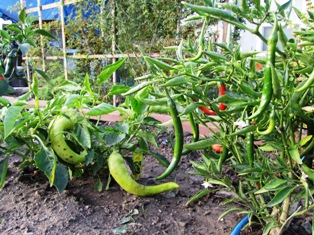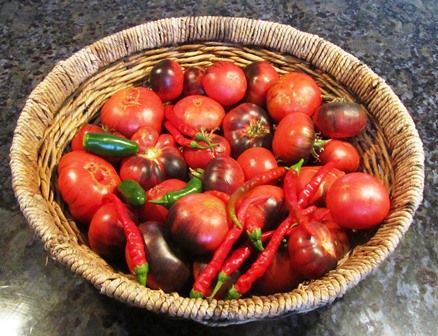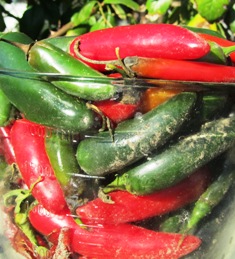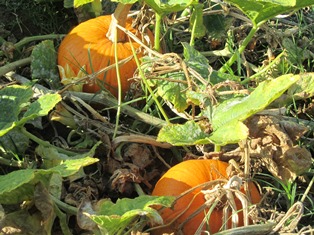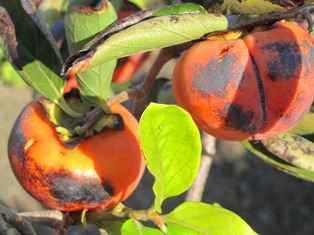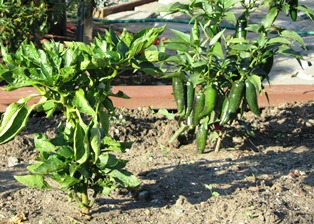Planting the Spring Garden
Winter brought us lots of rain and now the ground has warmed up and is ready to receive the heirloom seedlings of our favorite vegetables and herbs.
Tomatoes won’t set fruit until the nighttime temps hover around 55 degrees Fahrenheit, but I tucked in several seedlings of heirloom varieties (Bradley, Cherokee Purple, and Red Beefsteak). Victory Seeds offers a nice selection of open-pollinated, non GMO, rare heirloom seeds for a variety of tomatoes. See, http://www.victoryseeds.com/tomato.html
While I was digging, my neighbor’s bees decided to swarm. So I stopped gardening to check on my own bees. They’ve been humming like a truck engine, and there has been a lot of bee traffic. Concerned that they might swarm, I set aside my shovel and got out the swarm catcher, the lemon oil, and the hand pump sprayer. I positioned the swarm catcher in a tree across the yard, sprayed the tree with lemon oil, and went back to gardening.
I’ve readied a patch of ground for the sweet corn, squash, peppers, and beans. Also, in a large-size planter pot, I’ve tucked in flat Italian parsley, Italian oregano, dill, chives, and sweet basil. The patio pot will remain near the kitchen slider in full sun so I have culinary herbs at the ready when I need them.
The early sweet peas are taking off now and the garlic and onions I put in the garden last fall are about a foot high. The vegetables and herbs I plant now will provide me with plenty of nutritious offerings right up until late fall–one of the many reasons to plant a garden in spring.
Enjoy this blog? Check out my Henny Penny Farmette novels, available online and in traditional bookstores everywhere.
Finding Surprises in my December Garden

Open-pollinated, heirloom tomatoes produced lots of tasty fruit over the summer, but . . . in December?
It’s the second week of December and the Winter Solstice is about to arrive next week. Walking through the bleak garden landscape, I wasn’t expecting any of my summer plants to still be producing. But surprise, surprise.
A cluster of red grape tomatoes were still clinging to a vine that had become overgrown by weeds. Not only was fruit still hanging on the vine, but the plant was setting up new blooms. I can only assume the reason for that is that we’re having unseasonably warm temperatures in the Bay Area.
I harvested a 10-pound bag of red and yellow onions at summer’s end. Now I’ve got a new bed where the onion heads re-seeded. I do hope these bulb onions make it through to spring. I might just build a cold frame over them.
In raised beds, the jalapeno and Thai chili peppers that wilted and drooped during the terrible drought this summer have responded to recent rains with lots of ripe peppers and also new blooms.
It’s very strange as these babies need water and high heat; our Bay Area temperatures are hanging in the 60s Fahrenheit during these early days of December.
I harvested the pumpkins and squash but hadn’t yet pulled out the old vines for composting. The hard-skinned pumpkins and squashes can be peeled, cut into cubes, and frozen for use later in culinary creations such as soup.
Further on, I picked the last of the persimmons and pomegranates. These are my favorite fall fruits. And if you’ve ever dropped ripe pomegranate seeds onto the ground, you’ll soon see that the chickens love them, too.
Having uncovered all the garden’s surprises, my thoughts turn to how I’m going to lay out the garden next year and which heirlooms to grow. The garden soil needs to rest as we Bay Area gardeners welcome the rain now that the Pacific storm door has finally opened.
Experiment with New Varieties of Tomatoes and Peppers
Tomatoes are one of my favorite plants from the summer garden. So it’s not surprising that of all the seed catalogs that I get each spring, the Tomato Growers catalog is one of my favorites. It offers 60 full-color pages of mostly tomatoes, but also peppers and eggplant varieties, a listing of equipment and supplies (for example tomato strainers), and books for gardeners. See, http://www.tomatogrowers.com/
I voraciously read all the catalog copy about each type of tomato and pepper and then note the seeds I want to grow. Experimenting with different varieties enables me to experience new flavors, new textures, and other unique characteristics of each variety.
In early spring when my neighbors rush off to garden centers for seedling tomatoes shipped to local nurseries by growers, I begin the process of planting my tomato and pepper seed in cell flats. The flats remain in the warm kitchen until the plants have emerged and have four sets of leaves. Only then do I place them in the garden to allow them time to acclimatize (harden off).
Removing the plants from their cell packs, I plant the seedlings in a basin or hole with native soil mixed with chicken manure or vegetable food. In that basin, the tomatoes benefit from the warmth of the sun and deep watering after transplanting. I do not plant the peppers in basins.
Stressing the tomato plant by withholding water yields tomatoes higher in flavor but can reduce the size and quantity. Too much water, however, can leach nitrogen and other nutrients from the soil and cause the plant to produce lots of leaves but fewer blossoms and fruit.
Near the heat-loving tomatoes in my garden, I always tuck in a few bell peppers, pickling peppers, and hot chili peppers. The Serrano peppers are pungent like jalapeno peppers and measure roughly 5,000 Scoville units of heat. Other peppers such as the Trinidad Perfume and the Fooled You peppers have no heat but are prized as seasoning for dishes requiring peppers.
A word of caution about growing tomatoes. Don’t plant them in the same area of your garden more than three years in a row. Experts say move them around as tomatoes are heavy feeders and putting them in depleted soil or soil in which you’ve grown tomatoes that have become sick can infect your new plants.
If you are interested in the pros and cons of dry farming tomatoes (meaning reduced watering) for intensive flavor and higher sugar content, check out the interesting article on the Growing For Market newsletter. See, http://www.growingformarket.com/articles/Improve-tomato-flavor
 Facebook
Facebook Goodreads
Goodreads LinkedIn
LinkedIn Meera Lester
Meera Lester Twitter
Twitter





